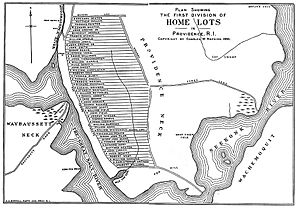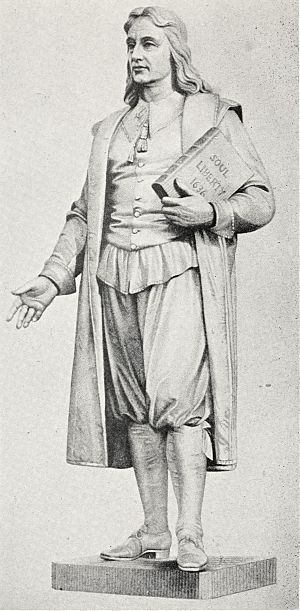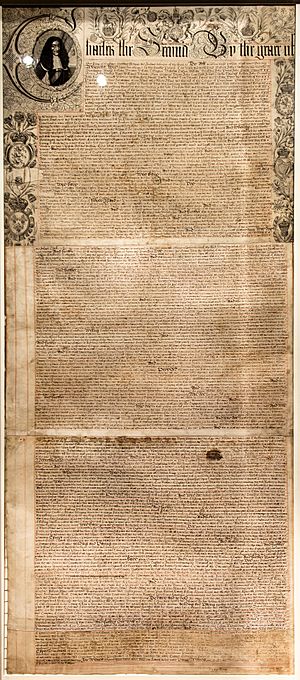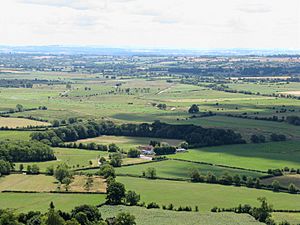Benedict Arnold (governor) facts for kids
Quick facts for kids
Benedict Arnold
|
|
|---|---|
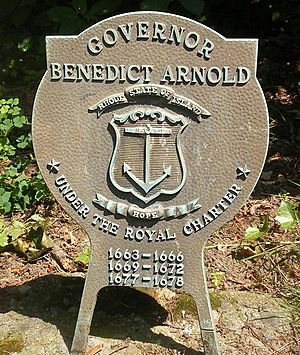
Governor Benedict Arnold grave medallion
|
|
| 10th and 12th President of the Colony of Rhode Island and Providence Plantations | |
| In office 1657–1660 |
|
| Preceded by | Roger Williams |
| Succeeded by | William Brenton |
| In office 1662–1663 |
|
| Preceded by | William Brenton |
| Succeeded by | Himself as governor |
| 1st, 3rd, and 7th Governor of the Colony of Rhode Island and Providence Plantations | |
| In office 1663–1666 |
|
| Preceded by | Himself as president |
| Succeeded by | William Brenton |
| In office 1669–1672 |
|
| Preceded by | William Brenton |
| Succeeded by | Nicholas Easton |
| In office 1677–1678 |
|
| Preceded by | Walter Clarke |
| Succeeded by | William Coddington |
| Personal details | |
| Born | 21 December 1615 Ilchester, Somerset |
| Died | 19 June 1678 (aged 62) Newport, Rhode Island |
| Resting place | Arnold Burying Ground, Pelham St., Newport |
| Spouse | Damaris Westcott |
| Children | 9 |
| Parents | William Arnold Christian Peak |
| Relatives | Benedict Arnold (great-grandson) |
| Occupation | Interpreter, Commissioner, President, Governor |
Benedict Arnold (born December 21, 1615 – died June 19, 1678) was an important leader in early America. He served as president and then governor of the Colony of Rhode Island and Providence Plantations. In total, he led the colony for 11 years.
Benedict Arnold was born and grew up in Ilchester, England. In 1635, at age 19, he sailed from England to New England with his family. They first settled in Hingham in the Massachusetts Bay Colony. Less than a year later, they moved to Providence Plantation. This move was at the request of Roger Williams. Around 1638, they moved again to a place called Pawtuxet.
Arnold learned the languages of the local Native American tribes when he was young. He became one of the main interpreters in the Rhode Island colony. The other main interpreter was Roger Williams. Arnold often helped during talks with Native Americans.
In 1651, Arnold and his family moved to Newport. He started his public service there. He became a freeman, a Commissioner, and an Assistant. In 1657, he took over from Roger Williams as president of the colony. He served for three years. In 1662, he was elected president again. During his second term, the Royal Charter of 1663 arrived from England. This charter named him the first governor of the colony. It also gave the colony many freedoms.
Arnold was a strong and clear-thinking leader. He was elected governor two more times. His last term was after the difficult King Philip's War. He died on June 19, 1678, while still in office. He was buried in the Arnold Burying Ground in Newport. In his will, he left his "stone built wind mill" to his wife. This building is now known as the Newport Tower. It is still an important landmark in Newport. Many famous people are related to Benedict Arnold. These include General Benedict Arnold, known for his actions during the American Revolutionary War. Another relative was Senator Stephen Arnold Douglas. He debated Abraham Lincoln in 1858.
Contents
Early Life in England and New England
Benedict Arnold was born on December 21, 1615. His parents were William Arnold and Christian Peak. He was their second child and oldest son. He likely went to school in Limington, near his hometown of Ilchester, England.
In the spring of 1635, when he was 19, his family moved to New England. They sailed from Dartmouth, England. Benedict Arnold wrote in a family record: "My father and his family Set Sail from Dartmouth in Old England, the first of May... Arrived in New England June 24o Ano 1635." It is possible that Stukeley Westcott and his daughter Damaris were on the same ship. Damaris, who was 15, later became Arnold's wife.
When they arrived, the Arnolds joined settlers from Hingham, England. They started the town of Hingham in the Massachusetts Bay Colony. In September 1635, William Arnold received land for a house. However, Roger Williams convinced them to move. The next spring, they joined Williams to start a new settlement. This new place was called Providence Plantation. Benedict Arnold wrote that they "came to Providence to Dwell the 20th of April, 1636." Arnold received a house lot in Providence.
Life in Providence and Pawtuxet
In 1637, Benedict Arnold was one of 13 settlers. They signed an agreement to follow decisions made by most families. Around 1638, he moved south to the Pawtuxet River. He moved with his father and other family members. This settlement was called Pawtuxet. It was still part of Providence Plantation.
On July 17, 1640, Arnold signed another agreement. This was with 38 other Providence residents. They wanted to create a more organized government. However, this did not go smoothly. There were disagreements with neighbors, especially Samuel Gorton. Arnold and 12 others asked Massachusetts for help. They asked Massachusetts to "lend us a neighborlike helping hand." Massachusetts said they could only help if the settlers were under their rule.
So, in September 1642, the Arnolds and others agreed to be under Massachusetts' rule. This meant a different government was now in the middle of Providence. This situation lasted for 16 years. Gorton was unhappy about this. He moved further south to a place called Shawomet.
Arnold and his father knew the Narragansett and Wampanoag languages well. They did not like Gorton. They found a way to challenge him and gain land from local Native Americans. Gorton had bought Shawomet from Miantonomi, a Narragansett chief. But minor chiefs, Ponham and Sacononoco, also had control of lands in Pawtuxet and Shawomet. Arnold, acting as interpreter, took these chiefs to Governor Winthrop in Boston. They claimed that Gorton's purchase of Shawomet was not fair. Massachusetts then claimed Shawomet. They told Gorton to come to Boston. When Gorton refused, Massachusetts sent people to arrest him. Gorton was later released. He went to England and got legal ownership of his lands. Shawomet was then renamed Warwick.
Arnold was very skilled in Native American languages. He was often asked to interpret during important talks. In June 1645, Massachusetts sent him to the Narragansett people. He was to ask them to stop fighting the Mohegans. A month later, Arnold refused to go back. He had been accused of misrepresenting what the tribes said. Roger Williams went as interpreter instead.
The Pawtuxet settlers staying under Massachusetts caused problems. Roger Williams and others in Rhode Island were annoyed. In 1649, the Rhode Island government asked Arnold and the Pawtuxet settlers to join the Rhode Island colony. But they stayed under Massachusetts for nine more years. Arnold and his father owned a lot of land. In 1650, Arnold paid the highest tax in the colony.
In June 1650, Roger Williams wrote that Arnold had bought a house in Newport. He planned to move there. Historians think he moved for business reasons. He might also have wanted to leave the tense situation in Providence.
Moving to Newport and Public Service
In 1651, Arnold left Providence and Pawtuxet. He settled in Newport on Aquidneck Island. He wrote: "We came from Providence with our family to Dwell at Newport in Rhode Island the 19th of November... Ano. Domina 1651." For the first 100 years of Rhode Island, leaders mostly came from Newport. Newport had organized courts and jury trials early on.
When Arnold arrived in Newport, big political changes were happening. William Coddington had separated Newport and Portsmouth from Providence and Warwick. He became governor for life of the island towns in 1651. Providence sent Roger Williams to England to fix this. Those on the island who opposed Coddington sent Dr. John Clarke and William Dyer. They wanted Coddington's charter removed. Williams and Dyer succeeded and returned. Clarke stayed in England for ten years to protect the colony's interests. In 1653, Coddington's power was removed. The four towns began to reunite under one government.
In 1653, Arnold became a freeman of Newport. From then until his death in 1678, he served in public office every year. In 1654, he became a Commissioner for Newport. He was an Assistant from 1655 to 1656. He was very active in government committees. In 1655, Arnold and others wrote a letter of thanks to England's Lord Protector, Oliver Cromwell. Arnold was given Cromwell's reply letter to keep.
In 1657, Arnold was elected President of the colony. He was 41 years old. He took over from Roger Williams.
Leading the Colony as President
Arnold became president at an important time for Rhode Island. Big political changes were happening in England. This created new chances for Rhode Island. The colony was often bothered by its larger neighbors, Massachusetts and Connecticut. Oliver Cromwell had ruled England since 1649. But he died in 1658. This led to the return of the monarchy. Charles II became king. Rhode Island quickly adapted to this new situation. In October 1660, the colony's leaders recognized the new king.
William Brenton replaced Arnold as president in 1660. But Arnold continued to serve as a Commissioner and Assistant. He led a committee to send a new request to Dr. Clarke in England. This request gave credit to King Charles I for the 1643 Patent. This Patent had officially created the Rhode Island colony. The document also mentioned problems from "claims of neighbors about us." This referred to Massachusetts and Connecticut wanting parts of Narragansett Bay. Dr. Clarke was named the colony's agent. The document showed great respect for King Charles II.
In this request, the four towns of Rhode Island showed their loyalty to the new king. Dr. Clarke, a skilled diplomat, used this to help the colony. He wrote a letter asking for a special kind of freedom. He wanted the colony to be "a Republic of Liberty under Law." This meant everyone would be free under the law.
Dealing with the Quakers
In 1658, other colonies like Massachusetts warned Rhode Island about the Quakers. They called Quakers "heretics" and wanted them removed. These colonies threatened to stop trading with Rhode Island if they didn't remove the Quakers. Arnold did not agree with all Quaker beliefs. But his reply showed Rhode Island's strong belief in religious freedom. He wrote that Rhode Island had "no law among us, whereby to punish any for only declaring by words... their minds and understandings concerning the things and days of God."
Arnold told Massachusetts Governor Simon Bradstreet that the Quakers' actions would be discussed. He hoped some steps would be taken to prevent "bad effects of their doctrines." In March 1658, the Rhode Island Assembly confirmed its rule of "freedom of different consciences." They told the other colonies that if problems arose from having Quakers, they would tell the King in England. After this, no more complaints came from the other colonies.
Serving as Governor
In 1662, Arnold was elected president again. In his second year, Dr. Clarke's hard work paid off. The Royal Charter of 1663 arrived. This charter was described as a great document for human liberty. Under this charter, Arnold became the first governor of the Colony of Rhode Island. William Brenton was his Deputy. The old government was replaced. There was now a legislature with ten Assistants and a House of Deputies.
One of Arnold's first actions as governor was to write to Governor Winthrop of Connecticut. He wrote about drawing a border between the two colonies. Arnold used a special chair as his "Chair of State." This chair is now at the Redwood Library and Athenaeum in Newport. He was sitting in this chair when he received the Charter.
In 1664, the King's Commissioners came to Rhode Island. They wanted to settle land claims in the Narragansett area. This included arguments between Rhode Island and Connecticut over land in Westerly and Wickford. The commissioners helped prevent a major fight. But the disputes between the two colonies continued for 50 years. The King's Commissioners also made Arnold a justice of the peace.
In 1666, Arnold left office. William Brenton became governor. However, Arnold was still asked to serve in the Assembly. In 1669, Arnold was chosen as governor again. He was re-elected in 1670. During this time, the land arguments with Connecticut became very serious. On July 11, 1670, Arnold sent a strong letter to Connecticut's Governor Winthrop. He said Rhode Island would complain to King Charles about Connecticut's actions.
During Arnold's time as governor, the Quakers found Rhode Island to be a safe place. They found success in spreading their religion. They also became a strong political group. Arnold was elected governor again in 1671. But in 1672, Quaker Nicholas Easton became governor. Quakers held power for three of the next five years. Arnold had a positive impact on the colony. After more than ten years of his leadership, the separate town governments were united. Courts were set up, and society became more organized.
Business and Land Interests
Arnold was very helpful to the colony. His successful political career was matched by his success in farming and trade. When he lived in Pawtuxet, he sold weapons, ammunition, and alcohol. He had a store that sold goods from Boston. Some people complained that Arnold traded with Native Americans on Sundays. They also said he gave them too much gunpowder and alcohol. They also said he would not sell items to Warwick settlers unless they agreed to Massachusetts' rule.
After leaving the governorship in 1672, Arnold likely focused on his businesses. He was said to be the wealthiest person in the colony. He owned a wharf and a warehouse. He also had business interests in the West Indies. In 1674, he wrote a letter to his son-in-law, asking him to finish business in Barbados.
Arnold owned several pieces of land in Newport. One of his properties was called "Lemmington Farm." He named it after Limington, his home village in England. In 1657, he was one of about 100 people who bought Conanicut Island. This is the second largest island in Narragansett Bay. The town of Jamestown is there now. He and John Greene also bought Goat Island and Coaster's Harbor Island. These later became property of Newport.
After January 1658, Arnold and six others bought a large area of land. This was known as the Pettaquamscutt Purchase. It later became South Kingstown, Rhode Island. He owned this land until he died. He left it to his three sons. He also owned two properties in Newport. One had his wharf and warehouse. The other was where his large house stood.
King Philip's War and Arnold's Last Term
King Philip's War (1675–76) badly damaged the mainland towns of Rhode Island. It was a very difficult conflict for New England. This war was between several Native American tribes and the colonists. It was named after Metacomet, a Wampanoag chief also called King Philip. Rhode Island had been more peaceful with Native Americans than other colonies. But it suffered a lot because it was in the middle of the fighting. Warwick and Pawtuxet were completely destroyed. Much of Providence was also destroyed. Several of Arnold's relatives fled to Long Island. His elderly father was moved to his brother's safe house but did not survive the war.
In April 1676, the Assembly asked for Arnold's help. They wanted his advice during these "troublesome times." Quaker Governor Walter Clarke was in office during the war. Even though the war had ended, the "war party" won the election of 1677. Arnold was voted back into office as governor.
During this term, Arnold's health began to fail. But he was still re-elected in May 1678. He was too ill to leave his house. His deputy governor John Cranston and others visited him at home to handle colony business. His health did not get better. He died within a month of his last election.
Death and What He Left Behind
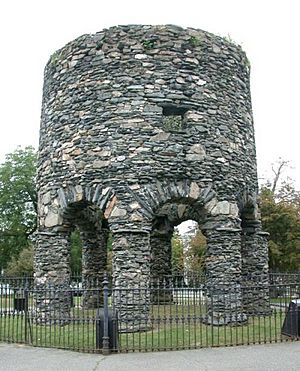
Arnold wrote his will on December 24, 1677. This was during his last full term as governor. He added a change to his will in February. He died in June while still in office. On June 29, Samuel Hubbard wrote that "Our Governor died the 19th day of June, 1678, buried 20th day." He said nearly a thousand people attended the funeral. In his will, Governor Arnold gave his wife land, his mansion house, and his "stone built wind mill." There are stories that early Norsemen built the stone structure in Newport. But the strongest evidence suggests it was the base of Arnold's windmill.
Benedict Arnold, his wife, and many family members are buried in the Arnold Burying Ground in Newport. For many years, the cemetery was hidden under a garden. But in 1949, a big project began. All the gravestones were found, cleaned, and put back in place. There are no words on the stones covering the governor and his wife's graves. But his grave has a special governor's medallion.
Lieutenant Governor and historian Samuel G. Arnold wrote about him: "He was not a fan of the ideas or actions of the Quakers. But like Williams, he understood the difference between hurting people for their beliefs and simply disagreeing with them. In politics and religion, he was against William Coddington and a friend of John Clarke. Throughout his long and helpful life, he showed great talent. He always used his skills for the good of others."
Family and Notable Descendants
Arnold married Damaris Westcott on December 17, 1640. She was the daughter of Stukeley Westcott. They had nine children: Benedict, Caleb, Josiah, Damaris, William, Penelope, Oliver, Godsgift, and Freelove. All but William grew up, married, and had children. His son Caleb was a doctor. He married Abigail Wilbur. She was the granddaughter of Samuel Wilbore and John Porter. Both of them signed the agreement that started the town of Portsmouth.
Famous people are descended from Benedict Arnold. Through his son Benedict, his great-grandson was also named Benedict Arnold. This general is known for his actions during the American Revolutionary War. Through his son Caleb Arnold, descendants include Commodore Oliver Hazard Perry. He was an American hero during the War of 1812. His younger brother, Commodore Matthew C. Perry, helped open Japan to the West in 1854. Senator Stephen Arnold Douglas is also a descendant. He debated Abraham Lincoln in 1858. He later lost to Lincoln in the 1860 presidential election. Rhode Island colonial Deputy Governor George Hazard is another descendant.
Ancestry of Benedict and Damaris Arnold
| Ancestors of Benedict Arnold (governor) | |||||||||||||||||||||||||||||||||||||||||||||||||||||||||||||||||||||||||||||||||||||||||||||||||||||||||||||||||||||||||||||||||||||||||||||||||||||||||||||||||||||||||||||||||||||||||||||||||||||||||||||||||||||||||||||||||||||||||||||||||||||||||||||||||||||||||||||||||||||||||||||||||||||||||||||||||||||||||||||||||||||||||||||||||||||||||||||||||||||||||||||||||||||||||||||||||||||||||||||||||||||||||||||||||||||||||||||||||||||||||||||||||||||||||||||||||||||||||||||||||||||||||||||||||||||||||||||||||||||||||||||
|---|---|---|---|---|---|---|---|---|---|---|---|---|---|---|---|---|---|---|---|---|---|---|---|---|---|---|---|---|---|---|---|---|---|---|---|---|---|---|---|---|---|---|---|---|---|---|---|---|---|---|---|---|---|---|---|---|---|---|---|---|---|---|---|---|---|---|---|---|---|---|---|---|---|---|---|---|---|---|---|---|---|---|---|---|---|---|---|---|---|---|---|---|---|---|---|---|---|---|---|---|---|---|---|---|---|---|---|---|---|---|---|---|---|---|---|---|---|---|---|---|---|---|---|---|---|---|---|---|---|---|---|---|---|---|---|---|---|---|---|---|---|---|---|---|---|---|---|---|---|---|---|---|---|---|---|---|---|---|---|---|---|---|---|---|---|---|---|---|---|---|---|---|---|---|---|---|---|---|---|---|---|---|---|---|---|---|---|---|---|---|---|---|---|---|---|---|---|---|---|---|---|---|---|---|---|---|---|---|---|---|---|---|---|---|---|---|---|---|---|---|---|---|---|---|---|---|---|---|---|---|---|---|---|---|---|---|---|---|---|---|---|---|---|---|---|---|---|---|---|---|---|---|---|---|---|---|---|---|---|---|---|---|---|---|---|---|---|---|---|---|---|---|---|---|---|---|---|---|---|---|---|---|---|---|---|---|---|---|---|---|---|---|---|---|---|---|---|---|---|---|---|---|---|---|---|---|---|---|---|---|---|---|---|---|---|---|---|---|---|---|---|---|---|---|---|---|---|---|---|---|---|---|---|---|---|---|---|---|---|---|---|---|---|---|---|---|---|---|---|---|---|---|---|---|---|---|---|---|---|---|---|---|---|---|---|---|---|---|---|---|---|---|---|---|---|---|---|---|---|---|---|---|---|---|---|---|---|---|---|---|---|---|---|---|---|---|---|---|---|---|---|---|---|---|---|---|---|---|---|---|---|---|---|---|---|---|---|---|---|---|---|---|---|---|---|---|---|---|---|---|---|---|---|---|---|---|---|---|---|---|---|---|---|---|---|---|---|---|---|---|---|---|---|---|---|---|---|---|---|---|---|---|---|---|---|---|---|---|---|---|---|---|---|---|---|---|---|---|---|---|---|---|---|---|---|---|---|---|---|---|---|---|---|---|---|---|---|---|---|---|---|---|---|---|---|---|---|---|---|---|---|---|---|---|---|---|---|---|---|---|---|---|---|---|---|
|
|||||||||||||||||||||||||||||||||||||||||||||||||||||||||||||||||||||||||||||||||||||||||||||||||||||||||||||||||||||||||||||||||||||||||||||||||||||||||||||||||||||||||||||||||||||||||||||||||||||||||||||||||||||||||||||||||||||||||||||||||||||||||||||||||||||||||||||||||||||||||||||||||||||||||||||||||||||||||||||||||||||||||||||||||||||||||||||||||||||||||||||||||||||||||||||||||||||||||||||||||||||||||||||||||||||||||||||||||||||||||||||||||||||||||||||||||||||||||||||||||||||||||||||||||||||||||||||||||||||||||||||


